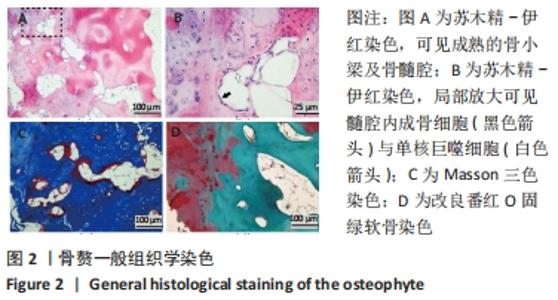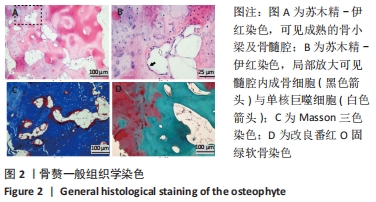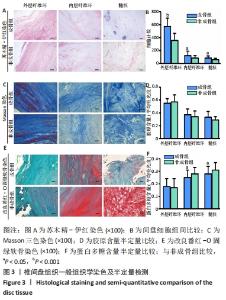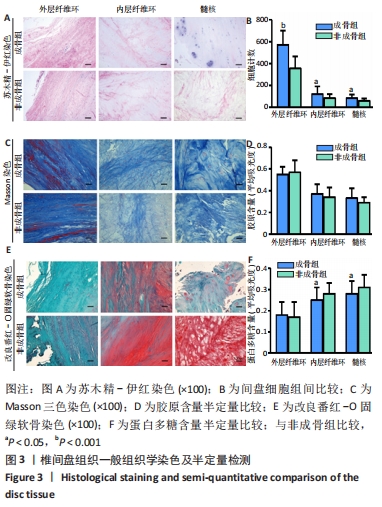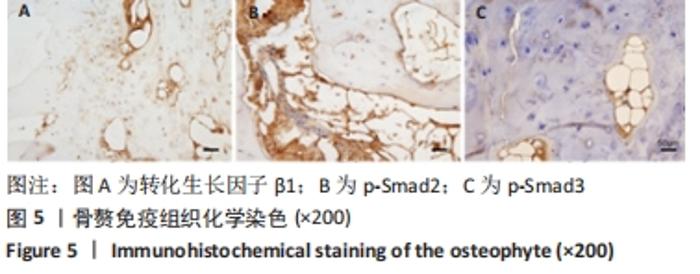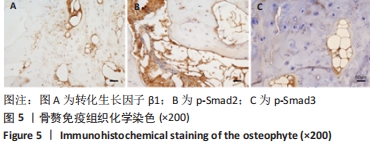Chinese Journal of Tissue Engineering Research ›› 2022, Vol. 26 ›› Issue (18): 2868-2873.doi: 10.12307/2022.696
Previous Articles Next Articles
Histological changes of cervical disc tissue and underlying ossification mechanism in patients with cervical degenerative ossification
Xiong Yang1, 2, Yang Yingli3, Gao Yushan4, Wang Xiumei2, Yang Yongdong1, Zhao Dingyan1, Zhao He1, Li Chuanhong1, Yang Kaitan1, Yu Xing1
- 1Department of Orthopedics, Dongzhimen Hospital, Beijing University of Chinese Medicine, Beijing 100700, China; 2School of Materials Science and Engineering, Tsinghua University, Beijing 100084, China; 3Department of Traditional Chinese Medicine, Peking Union Medical College Hospital, Beijing 100032, China; 4School of Chinese Medicine, Beijing University of Chinese Medicine, Beijing 100029, China
-
Received:2021-04-19Accepted:2021-06-27Online:2022-06-28Published:2022-01-30 -
Contact:Yu Xing, Professor, Chief physician, Department of Orthopedics, Dongzhimen Hospital, Beijing University of Chinese Medicine, Beijing 100700, China -
About author:Xiong Yang, MD, Department of Orthopedics, Dongzhimen Hospital, Beijing University of Chinese Medicine, Beijing 100700, China; School of Materials Science and Engineering, Tsinghua University, Beijing 100084, China Yang Yingli, MD, Physician, Department of Traditional Chinese Medicine, Peking Union Medical College Hospital, Beijing 100032, China Xiong Yang and Yang Yingli contributed equally to this article. -
Supported by:the Curative Effect of Biomimetic Mineralized Collagen Bone in the Treatment of Spinal Diseases and Fractures (to YX)
CLC Number:
Cite this article
Xiong Yang, Yang Yingli, Gao Yushan, Wang Xiumei, Yang Yongdong, Zhao Dingyan, Zhao He, Li Chuanhong, Yang Kaitan, Yu Xing. Histological changes of cervical disc tissue and underlying ossification mechanism in patients with cervical degenerative ossification[J]. Chinese Journal of Tissue Engineering Research, 2022, 26(18): 2868-2873.
share this article
Add to citation manager EndNote|Reference Manager|ProCite|BibTeX|RefWorks
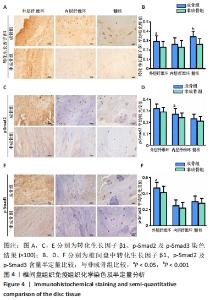
苏木精-伊红染色结果显示(图2A,B及3A),椎间盘内从外层纤维环到内层纤维环再到髓核各部分组织结构具有明显差异。由外到内,胶原纤维束排列由相互平行、致密逐渐变为紊乱交错、稀疏。同时,细胞数量逐渐减少。外层纤维环中细胞细长呈梭形,整体形态类似于成纤维细胞,排列多与胶原纤维走向平行或连接成串。内层纤维环中细胞大多散在分布,形态呈卵圆形或球形,整体类似于软骨细胞。髓核中细胞稀疏,部分软骨样细胞散在分布,另有部分聚集呈脊索样细胞,胞外基质中纤维结构模糊不清。成骨组骨赘中可见到成熟的骨结构,包括骨小梁、骨髓腔及骨陷窝,髓腔中可见成骨细胞及破骨细胞或其前体单核巨噬细胞。Masson三色染色结果显示(图2C,3C),椎间盘内纤维及骨赘均呈蓝染,椎间盘内纤维排列由外到内亦具有减少趋势,结果同苏木精-伊红染色。改良番红O-固绿软骨染色可见(图2D, 3E),外层纤维环以绿色为主,内层纤维环为红绿相间,髓核则以红色为主,反映出椎间盘基质中蛋白多糖主要分布于内层纤维环与髓核中。成骨组骨赘染色可见骨小梁呈绿色或灰绿色,骨髓腔中可见大量空泡,细胞外基质红绿相间,在近骨小梁处,可见红染、增生、肥大的类软骨细胞,这表明局部骨组织或通过软骨内化骨形成。 半定量检测显示(图3B,D,F),成骨组椎间盘各部分细胞数量均显著高于非成骨组,差异有显著性意义(外层纤维环中P < 0.001,内层纤维环及髓核中P=0.04,0.01)。椎间盘组织从外到内,胶原纤维含量逐渐减少,但组间比较差异无显著性意义(外层纤维环、内层纤维环及髓核中P=0.83,0.17,0.11)。椎间盘基质中蛋白多糖含量逐渐增加,组间比较可见,成骨组内层纤维环和髓核中蛋白多糖含量著低于非成骨组,差异有显著性意义(外层纤维环、内层纤维环及髓核中P=0.40,0.02,0.04)。 2.2 免疫组织化学染色 所有退变椎间盘组织及骨赘中均可见转化生长因子β1、p-Smad2及p-Smad3的阳性表达,这表明转化生长因子β1/Smad2/3参与到了椎间盘的退变及骨赘的形成过程中。半定量检测显示,与非成骨组比较,成骨组外层纤维环和髓核中的转化生长因子β1含量显著更高,差异有显著性意义(外层纤维环、内层纤维环中P=0.001,0.09,髓核中P < 0.001)。成骨组内层纤维环中p-Smad2及外层纤维环中p-Smad3表达量均显著高于非成骨组,差异有显著性意义(p-Smad2:外层纤维环、内层纤维环及髓核中P=0.07,0.04,0.31;p-Smad3:外层纤维环、内层纤维环及髓核中P=0.02,0.15,0.28),见图4,5。"
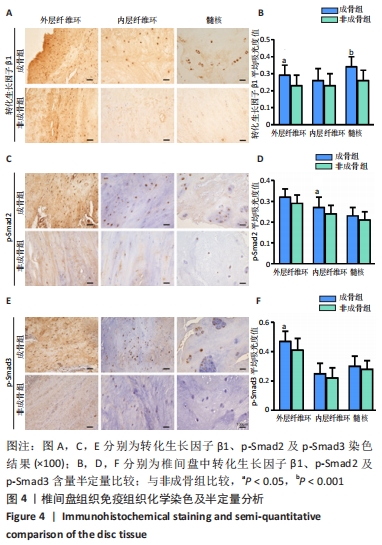
| [1] FUSELLIER M, CLOUET J, GAUTHIER O, et al. Degenerative lumbar disc disease: in vivo data support the rationale for the selection of appropriate animal models. Eur Cells Mater. 2020;39:18-47. [2] PĘKALA P, TATERRA D, KRUPA K, et al. Correlation of morphological and radiological characteristics of degenerative disc disease in lumbar spine: a cadaveric study. Folia Morphologica. 2021. doi: 10.5603/FM.a2021.0040. [3] GANDHI AA, GROSLAND NM, KALLEMEYN NA, et al. Biomechanical analysis of the cervical spine following disc degeneration, disc fusion, and disc replacement: a finite element study. Int J Spine Surg. 2019;13(6):491-500. [4] 解志锋, 刘清, 刘冰, 等.腰椎间盘疲劳损伤的生物力学特性[J].中国组织工程研究,2021,25(3):339-343. [5] LEE SH, SON DW, LEE JS, et al. Relationship between endplate defects, modic change, facet joint degeneration, and disc degeneration of cervical spine. Neurospine. 2020;17(2):443-452. [6] CAI XY, SANG D, YUCHI CX, et al. Using finite element analysis to determine effects of the motion loading method on facet joint forces after cervical disc degeneration. Comput Biol Med. 2020;116:103519. [7] KIM KS, ROGERS LF, REGENBOGEN V. Pitfalls in plain film diagnosis of cervical spine injuries: false positive interpretation. Surgical neurology, 1986;25(4):381-392. [8] EERD MV, PATIJN J, LOEFFEN D, et al. The Diagnostic Value of an X‐ray based scoring system for degeneration of the cervical spine: A Reproducibility and Validation study. Pain Pract. 2021;21(7):766-777. [9] BOODY BS, LENDNER M, VACCARO AR. Ossification of the posterior longitudinal ligament in the cervical spine: a review. Int Orthop. 2019; 43(4):797-805. [10] LI G, WANG Q, LIU H, et al. Postoperative Heterotopic Ossification After Cervical Disc Replacement Is Likely a Reflection of the Degeneration Process. World Neurosurg. 2019;125:e1063-e1068. [11] LEE SE, CHUNG CK, JAHNG TA. Early development and progression of heterotopic ossification in cervical total disc replacement. J Neurosurg Spine. 2012;16(1):31-36. [12] HUI N, PHAN K, CHENG H, et al. Complications of cervical total disc replacement and their associations with heterotopic ossification: a systematic review and meta-analysis. Eur Spine J. 2020;29(11):2688-2700. [13] JIN H, SHEN J, WANG B, et al. TGF-β signaling plays an essential role in the growth and maintenance of intervertebral disc tissue. FEBS Lett. 2011;585(8):1209-1215. [14] TOLONEN J, GRÖNBLAD M, VIRRI J, et al. Transforming growth factor beta receptor induction in herniated intervertebral disc tissue: an immunohistochemical study. Eur Spine J. 2001;10(2):172-176. [15] SAMPARA P, BANALA RR, VEMURI SK, et al. Understanding the molecular biology of intervertebral disc degeneration and potential gene therapy strategies for regeneration: a review. Gene Ther. 2018;25(2):67-82. [16] Shapiro IM, Risbud MV. Intervertebral Disc. Springer Verlag Gmbh. 2016. [17] GULLBRAND SE, MALHOTRA NR, SCHAER TP, et al. A large animal model that recapitulates the spectrum of human intervertebral disc degeneration. Osteoarthritis Cartilage. 2017;25(1):146-156. [18] RUTGES JP, DUIT RA, KUMMER JA, et al. A validated new histological classification for intervertebral disc degeneration. Osteoarthritis Cartilage. 2013;21(12):2039-2047. [19] LAWSON LY, HARFE BD. Developmental mechanisms of intervertebral disc and vertebral column formation. Wiley Interdiscip Rev Dev Biol. 2017;6(6). doi: 10.1002/wdev.283. [20] LI H, LI W, LIANG B, et al. Role of AP-2α/TGF-β1/Smad3 axis in rats with intervertebral disc degeneration. Life Sci. 2020;263:118567. [21] YING J, WANG P, ZHANG S, et al. Transforming growth factor-beta1 promotes articular cartilage repair through canonical Smad and Hippo pathways in bone mesenchymal stem cells. Life Sci. 2018;192: 84-90. [22] 李楠,修磊,关涛,等. TGF-β1和结缔组织生长因子在不同退变程度的腰椎间盘组织中的表达[J]. 中国修复重建外科杂志,2014, 28(7):891-895. [23] 陈岩, 胡有谷, 吕振华. 转化生长因子β对椎间盘细胞Ⅱ型胶原基因表达的调节作用[J]. 中华外科杂志,2000,38(9):62-65. [24] CUCCHIARINI M, ASEN AK, GOEBEL L, et al. Effects of TGF-β Overexpression via rAAV Gene Transfer on the Early Repair Processes in an Osteochondral Defect Model in Minipigs. Am J Sports Med. 2018; 46(8):1987-1996. [25] LI Y, ZOU N, WANG J, et al. TGF-β1/Smad3 Signaling Pathway Mediates T-2 Toxin-Induced Decrease of Type II Collagen in Cultured Rat Chondrocytes. Toxins (Basel). 2017;9(11):359. [26] HU Y, TANG JS, HOU SX, et al. Neuroprotective effects of curcumin alleviate lumbar intervertebral disc degeneration through regulating the expression of iNOS, COX‑2, TGF‑β1/2, MMP‑9 and BDNF in a rat model. Mol Med Rep. 2017;16(5):6864-6869. [27] BIAN Q, JAIN A, XU X, et al. Excessive Activation of TGFβ by Spinal Instability Causes Vertebral Endplate Sclerosis. Sci Rep. 2016;6:27093. [28] BIAN Q, MA L, JAIN A, et al. Mechanosignaling activation of TGF-β maintains intervertebral disc homeostasis. Bone Res. 2017;5:17008. [29] ZHU J, ZHANG X, GAO W, et al. lncRNA/circRNA-miRNA-mRNA ceRNA network in lumbar intervertebral disc degeneration. Mol Med Rep. 2019;20(4):3160-3174. [30] ZHANG J, LI Z, CHEN F, et al. TGF-beta1 suppresses CCL3/4 expression through the ERK signaling pathway and inhibits intervertebral disc degeneration and inflammation-related pain in a rat model. Exp Mol Med. 2017;49(9):e379. [31] LI H, LI W, LIANG B, et al. Role of AP-2alpha/TGF-beta1/Smad3 axis in rats with intervertebral disc degeneration. Life Sci. 2020;263:118567. [32] YANG H, CAO C, WU C, et al. TGF-betal Suppresses Inflammation in Cell Therapy for Intervertebral Disc Degeneration. Sci Rep. 2015;5:13254. [33] XU G, LIU Y, ZHANG C, et al. Temporal and spatial expression of Sox9, Pax1, TGF-beta1 and type I and II collagen in human intervertebral disc development. Neurochirurgie. 2020;66(3):168-173. [34] PAN D, ZHANG Z, CHEN D, et al. Morphological Alteration and TGF-beta1 Expression in Multifidus with Lumbar Disc Herniation. Indian J Orthop. 2020;54(Suppl 1):141-149. [35] LEE YJ, KONG MH, SONG KY, et al. The Relation Between Sox9, TGF-beta1, and Proteoglycan in Human Intervertebral Disc Cells. J Korean Neurosurg Soc. 2008;43(3):149-154. [36] ZHEN G, WEN C, JIA X, et al. Inhibition of TGF-β signaling in mesenchymal stem cells of subchondral bone attenuates osteoarthritis. Nat Med. 2013;19(6):704-712. [37] HUANG YZ, ZHAO L, ZHU Y, et al. Interrupting TGF-β1/CCN2/integrin-α5β1 signaling alleviates high mechanical-stress caused chondrocyte fibrosis. Eur Rev Med Pharmacol Sci. 2021;25(3):1233-1241. [38] 吴红,王岚,杨玉涛,等.TGF-β1/Smad2/3信号通路在椎间盘退变中的作用[J]. 基因组学与应用生物学,2019,38(9):4236-4240. [39] 达逸峰,黄智,郑文凯,等 . JAK1/STAT3协同TGF-β/Smad2/3信号通路调控TSLP对突出椎间盘重吸收的影响[J]. 中华骨科杂志,2020, 40(11):734-742. [40] 李钟奇. 椎间盘退变关键标志物筛选及携载TGF--β3支架对椎间盘修复的实验研究[D]. 济南:山东大学,2020. [41] YANG H, YUAN C, WU C, et al. The role of TGF-β1/Smad2/3 pathway in platelet-rich plasma in retarding intervertebral disc degeneration. J Cell Mol Med. 2016;20(8):1542-1549. [42] YING J, WANG P, ZHANG S, et al. Transforming growth factor-beta1 promotes articular cartilage repair through canonical Smad and Hippo pathways in bone mesenchymal stem cells. Life Sci. 2018;192:84-90. [43] HE G, CHEN J, HUANG D. miR‑877‑3p promotes TGF‑β1‑induced osteoblast differentiation of MC3T3‑E1 cells by targeting Smad7. Exp Ther Med. 2019;18(1):312-319. [44] DE KROON LM, NARCISI R, VAN DEN AKKER GG, et al. SMAD3 and SMAD4 have a more dominant role than SMAD2 in TGFβ-induced chondrogenic differentiation of bone marrow-derived mesenchymal stem cells. Sci Rep. 2017;7:43164. [45] HUANG S, CHEN B, HUMERES C, et al. The role of Smad2 and Smad3 in regulating homeostatic functions of fibroblasts in vitro and in adult mice. Biochim Biophys Acta Mol Cell Res. 2020;1867(7):118703. |
| [1] | Zhang Haobo, Zhao Yunan, Yang Xuejun. Role and therapeutic implications of pyroptosis in intervertebral disc degeneration [J]. Chinese Journal of Tissue Engineering Research, 2022, 26(9): 1445-1451. |
| [2] | Wu Cong, Jia Quanzhong, Liu Lun. Relationship between transforming growth factor beta1 expression and chondrocyte migration in adult articular cartilage after fragmentation [J]. Chinese Journal of Tissue Engineering Research, 2022, 26(8): 1167-1172. |
| [3] | Li Jian, Bao Zhengqi, Zhou Pinghui, Zhu Ruizhi, Li Zhixiang, Wang Jinzi. Effects of posterior single open-door laminoplasty and anterior cervical corpectomy fusion on cervical sagittal balance parameters in the treatment of multilevel cervical spondylotic myelopathy [J]. Chinese Journal of Tissue Engineering Research, 2022, 26(6): 949-953. |
| [4] | Zhang Qi, Xiong Yang, Yu Xing, Yang Yongdong, Song Jiawei, Qiu Ziye, Ma Yukun, Jiang Guozheng, Feng Ningning, Wang Shuyang. Mobi-C combined with ROI-C fusion cage versus ROI-C fusion cage alone for the treatment of two-level cervical spondylosis: midterm efficacy follow-up [J]. Chinese Journal of Tissue Engineering Research, 2022, 26(3): 397-402. |
| [5] | Zhang Rong, Liang Zhenting, Yang Chun, Liu Dongdong, Xi Yin, Zhang Jie, Wang Ya, Xu Yonghao, Liu Xiaoqing, Li Yimin. Effects of mechanical stretch on fiber proliferation in human lung epithelial cells [J]. Chinese Journal of Tissue Engineering Research, 2022, 26(24): 3821-3825. |
| [6] | Yang Shukai, Wa Qingbiao, Yuan Xiaoyan. Moist exposed burn ointment intervenes with wound healing and expression of alpha-smooth muscle actin in burn model rats [J]. Chinese Journal of Tissue Engineering Research, 2022, 26(23): 3762-3767. |
| [7] | Deng Bowen, Li Xiaoye, Jiang Shengyuan, Liu Gan, Zhao Yi, Zhang Houjun, He Feng, Mu Xiaohong. Mechanisms of Huangqi Guizhi Wuwu Decoction in the treatment of cervical spondylosis and anxiety disorder based on the principle of “treating different diseases with the same method”: a network pharmacology analysis [J]. Chinese Journal of Tissue Engineering Research, 2022, 26(23): 3650-3656. |
| [8] | Guo Xiaopeng, Liu Yingsong, Shang Hui. Silk fibroin/nano hydroxyapatite composite combined with icariin can promote the proliferation and differentiation of bone marrow mesenchymal stem cells into nucleus pulposus like cells [J]. Chinese Journal of Tissue Engineering Research, 2022, 26(22): 3528-3534. |
| [9] | Ji Linsong, Wang Yanping, Lu tingsheng, Jia Yijia, Luo Chunshan. 3D printed porous titanium alloy fusion cage and autologous iliac bone in the treatment of cervical spondylotic myelopathy [J]. Chinese Journal of Tissue Engineering Research, 2022, 26(18): 2817-2822. |
| [10] | Yin Xunlu, Jin Zhefeng, Zhu Liguo, Feng Minshan, Yu Jie, Wei Xu, Zhan Jiawen, Gao Chunyu, Yin He, Liang Long, Han Tao, Sun Kai, Xie Rui . Effect and mechanism of mechanical factors on intervertebral disc degeneration [J]. Chinese Journal of Tissue Engineering Research, 2022, 26(12): 1816-1821. |
| [11] | Zhang Lei, Xiu Chunmei, Ni Li, Chen Jianquan. Identification and expression analysis of mouse nucleus pulposus specific markers [J]. Chinese Journal of Tissue Engineering Research, 2022, 26(11): 1669-1674. |
| [12] | Yu Dong, Liu Kan, Shi Zongting, Yang Xiaoxia, Liu Hengping, Zhang Qingfeng. Pathological changes of the cervical intervertebral discs and rules of migration and apoptosis in endplate chondrocytes in a rabbit model of dynamic disequilibrium [J]. Chinese Journal of Tissue Engineering Research, 2022, 26(11): 1675-1679. |
| [13] | Wei Haoxin, Wang Caiping, Deng Qian, Song Yan, Wang Xiaowen, Wang Jinwu. Design and clinical application of personalized cervical spine correction pillow with three-dimensional printing [J]. Chinese Journal of Tissue Engineering Research, 2021, 25(36): 5741-5746. |
| [14] | Liu Yanlu, Hu Wei, Aikebaier, Yiliya, Huang Yifei. Inhibition of galectin-3 promotes apoptosis of cartilage endplate cells and induces intervertebral disc degeneration [J]. Chinese Journal of Tissue Engineering Research, 2021, 25(35): 5599-5603. |
| [15] | Wang Shuguang, Cai Tongchuan, Feng Xinmin, Nan Liping, Wang Feng, Zhu Lei, Chen Dong, Zhang Liang. Meta-analysis of adverse events between anterior and posterior fusion surgery for multiple-level cervical spondylosis [J]. Chinese Journal of Tissue Engineering Research, 2021, 25(30): 4907-4914. |
| Viewed | ||||||
|
Full text |
|
|||||
|
Abstract |
|
|||||
